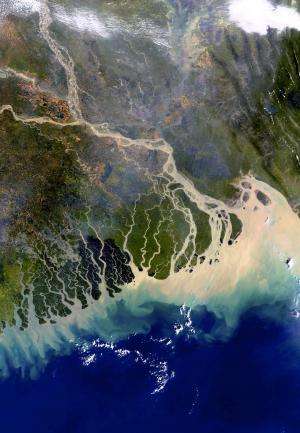Study reveals leakage of carbon from land to rivers, lakes, estuaries and coastal regions

When carbon is emitted by human activities into the atmosphere it is generally thought that about half remains in the atmosphere and the remainder is stored in the oceans and on land. New research suggests that human activity could be increasing the movement of carbon from land to rivers, estuaries and the coastal zone indicating that large quantities of anthropogenic carbon may be hidden in regions not previously considered.
The research, published in Nature Geoscience and led by researchers from the Université Libre de Bruxelles, the University of Exeter, Laboratoire des Sciences du Climat et l'Environnement, the University of Hawai'i and ETH Zürich, has for the first time shown that increased leaching of carbon from soil, mainly due to deforestation, sewage inputs and increased weathering, has resulted in less carbon being stored on land and more stored in rivers, streams, lakes, reservoirs, estuaries and coastal zones – environments that are together known as the 'land-ocean aquatic continuum'.
The study reviewed previously published data and showed that a significant fraction of the carbon emitted through human activity that is taken up by the land is not actually stored there, but in the aquatic continuum.
Pierre Regnier from Université Libre de Bruxelles said: "The budget of anthropogenic CO2 reported by the Intergovernmental Panel on Climate Change (IPCC) currently does not take into account the carbon leaking from terrestrial ecosystems to rivers, estuaries and coastal regions. As a result of this leakage, the actual storage by terrestrial ecosystems is about 40% lower than the current estimates by the IPCC."
The 'land-ocean aquatic continuum', has not previously been considered an important carbon sink. Future assessments of carbon storage must now take into account the surface areas of the land-ocean aquatic continuum to ensure accurate estimation of carbon storage. This will also require an improved knowledge of the mechanisms controlling the degradation, preservation and emissions of carbon along the aquatic continuum to fully understand the impact of human activity on carbon transfer.
Professor Pierre Friedlingstein from the University of Exeter said: "Carbon storage in sediments in these rivers and coastal regions could present a more secure environment than carbon stored in soil on land. As soil warms up stored carbon can be lost to the atmosphere. The chances of this occurring in wet sediments are reduced."
A fraction of the carbon that leaches from land to the land-ocean aquatic continuum is emitted back to the atmosphere, while another fraction is sequestered in sediments along the continuum. Only a minor part, about 10%, eventually reaches the open ocean.
Philippe Ciais from the Laboratoire des Sciences du Climat et l'Environnement said: "Our revisited global carbon budget which includes the land-ocean aquatic continuum is still entailed with significant uncertainties. It is however fully consistent with the observed growth rate of atmospheric CO2. Our downward revision of the land carbon storage is also in agreement with very recent results from forest inventories."
A significant part of the carbon storage thought to be offered by ecosystems on land - mainly forests - is thus negated by this leakage of carbon from soils to aquatic systems, and to the atmosphere.
More information: 'Anthropogenic perturbation of the carbon fluxes from land to ocean' Nature Geoscience June 9, 2013: dx.doi.org/10.1038/NGEO1830
Journal information: Nature Geoscience
Provided by University of Exeter















